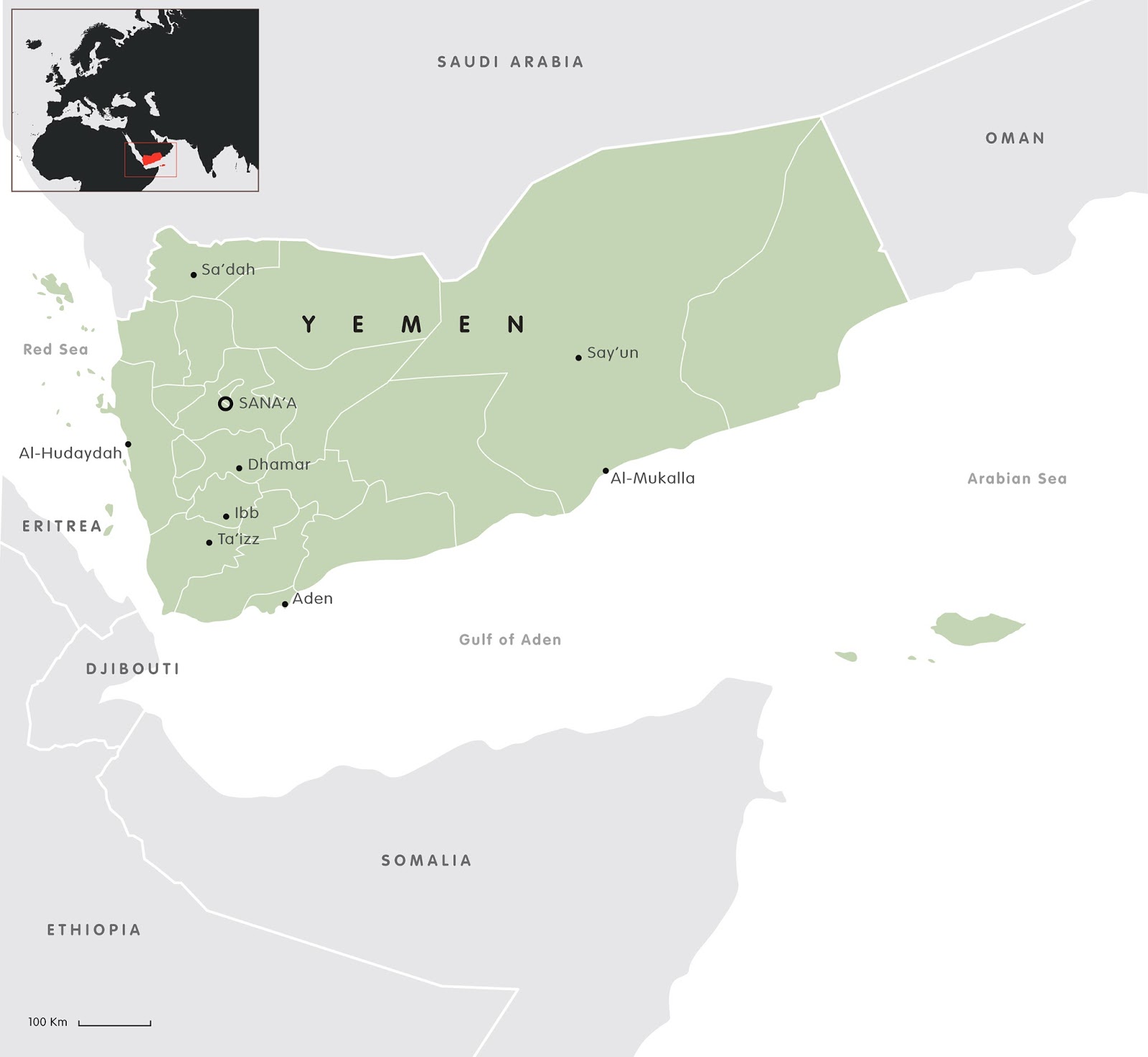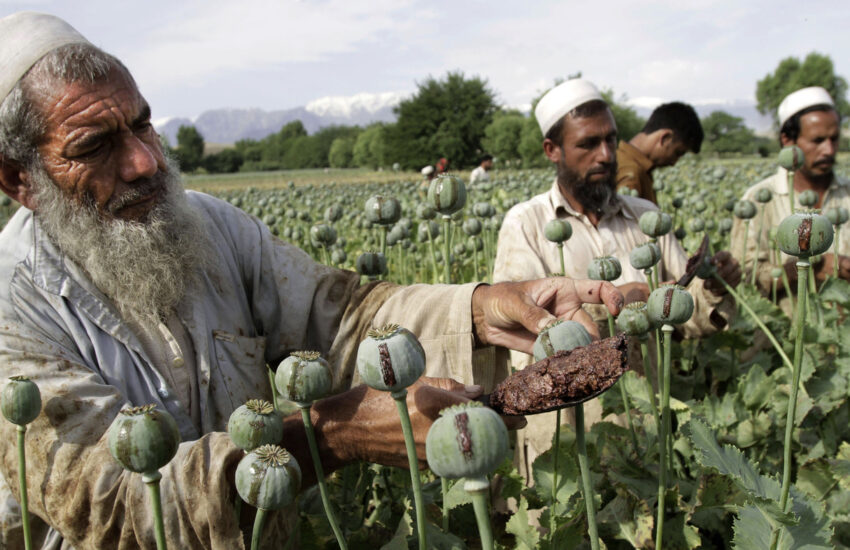MAPPING THE YEMEN CONFLICT

In March 2015, the president of Yemen, Abdo Rabbu Mansour Hadi, was forced to flee the country by Houthi rebels. The Zaidi Shia Houthis were supported by elements of Yemen’s military loyal to the country’s former president, Ali Abdullah Saleh. In response, Saudi Arabia formed a coalition of a dozen countries to restore Yemen’s internationally recognised government to power. The coalition included the Gulf Cooperation Council states (with the exception of Oman), Egypt, and Sudan, and was backed by the United States and United Kingdom.
Two years since the launch of the Saudi-led campaign, peace in the troubled country seems as far off as ever. President Hadi and his prime minister, Ahmed Obaid bin Daghir, now govern from the port city of Aden, which they declared the temporary capital. The bulk of Yemen’s northern highlands, and the capital city of Sanaa, remain under the control of the Houthis and their allies. Amid ongoing fighting, conditions in the country continue to deteriorate. The country’s infrastructure and industrial capacity are in ruins, and the humanitarian crisis is edging toward famine. Even areas now under the control of the Hadi government are riven with instability.
The unrest in Yemen is not a single conflict but is instead a mosaic of multifaceted regional, local, and international power struggles which are the legacy of recent and long-past events. The following maps aim to illustrate key aspects of this civil war and Yemen’s historical divisions.
HISTORICAL DIVISION (1962)
While the concept of Yemen as a distinct territory predates Islam, it has rarely been under the rule of a single government. For much of the past century, the country was split into the northern Yemen Arab Republic (YAR) and the southern People’s Democratic Republic of Yemen (PDRY). These were unified in 1990. The line separating north and south reflected the country’s division under British and Ottoman rule. But the cultural differences between the two regions are real – and accentuated by their divergent histories. Culture and politics in the north are coloured by over 1,000 years of Zaidi theocratic rule – a branch of Shi’ism found almost exclusively in Yemen. By contrast, the south was transformed by a century of British influence, beginning in the mid-19th century. Great Britain ran the strategic port of Aden directly as a colony and established itself in the port’s hinterlands and other areas of the south through financial and military aid. It struck deals with the heads of the various sultanates, sheikhdoms and emirates that constituted the Federation of South Arabia and the neighbouring Protectorate of South Arabia The differences between north and south only deepened after the withdrawal of the British in 1967 and the subsequent decades of rule under the PDRY, which was the only Marxist state in the Arab world.
RELIGIOUS DIVISIONS
Yemen’s religious divides largely parallel the country’s geography. Zaidi Shi’ism predominates in the northern highlands, alongside a small Isma’ili minority; Sunnis form the majority elsewhere. Historically, sectarianism has been minimal. Intermarriage between Sunnis and Zaidis is considered routine and, until recently, Yemenis of different sects prayed at the same mosques without a second thought. But the rise of political Islam – like the Muslim Brotherhood-linked Islah Party and Zaidi Houthis – has raised tensions. So too has the spread of Sunni ideology –particularly Salafism – in traditionally Zaidi areas. This was a key contributing factor in the emergence of the Houthi movement.
CURRENT FRONT LINES
The Houthi rebels and their allies are fighting a mix of Saudi- and Emirati-backed Yemeni government troops, Islamist militants, and tribal fighters. The Houthis were forced out of the bulk of Yemen’s southern provinces in summer 2015 and since the start of 2017 have faced increased pressure along the country’s Red Sea coast. But, despite heavy air bombardment by the Saudi-led coalition, the Houthis maintain a hold in key central provinces. Meanwhile, battle lines in much of the country have been static for most of the past year.
KEY FRONTS
While the Houthis and their allies have largely been forced out of the southern provinces, they continue to dominate elsewhere. This is in spite of continuing airstrikes, a naval blockade by Saudi-led coalition forces, and the efforts of anti-Houthi militias active on the ground in Yemen. In Ta’izz, Yemen’s third largest city, local militias have expelled the Houthis from large sections of the city but have failed to break the fighters’ siege. Along the Red Sea coast of Ta’izz province, a coalition-led military offensive has made notable progress.
The Saudi-led coalition has solidified its hold on much of the province of Marib. However, year-old predictions of the imminent fall of Sanaa have yet to come to pass.
HOUTHI EXPANSION (2012-2015)
The Houthis emerged out of Yemen’s mountainous far north in 2004 from ‘Believing Youth,’ a revivalist Zaidi Shi’a movement fuelled by local fears of encroachment by Sunni ideologies. While initial fighting was largely limited to the Houthi strongholds in mountainous areas in Saada, it soon spread to northern areas of Amran and western areas of al-Jawf. The Houthis gained control of Saada province during the unrest in Yemen in 2011 inspired by the Arab uprisings. In September 2014, they seized Sanaa, and swiftly expanded their control south to Ibb province and west to al-Hudayda.
Following President Hadi’s forced resignation in January 2015, the Houthis advanced southward to Abyan, Aden, and Lahj. In July and August 2015 they were pushed back by militia fighters supported by the Saudi-led coalition.
AL-QAEDA PRESENCE
For many years now, jihadi fighters returning to Yemen from Afghanistan and Iraq have continued the fight in the country’s patchily governed deserts and mountains. A Yemen-based group, al-Qaeda in the Arabian Peninsula (AQAP), is considered one of al-Qaeda’s most effective branches. The United States has waged an ongoing drone campaign against AQAP in response to the group’s attempts to strike American targets in the US itself and abroad. In the wake of Yemen’s 2011 uprising, militants affiliated with al-Qaeda, fighting under the banner of Ansar al-Sharia – the ‘Supporters of Islamic Law’ – seized swathes of the southern province of Abyan. There they established Islamic emirates in the towns of Ja’ar and Zinjibar and eventually seized the town of Rada, in al-Bayda, in early 2012. Although they were pushed out of Abyan in a US-backed Yemeni military offensive the following spring, they re-established themselves in the mountains of Mahfad and Azzan to the south. They were then ousted from there in 2014. In the tumult unleashed by the Houthi takeover of Sanaa and subsequent Saudi-led coalition airstrikes, fighters linked to al-Qaeda gained renewed operating space. They took control of al-Mukalla, Yemen’s fifth largest port, backed by allied local forces. An Emirati-backed military offensive in spring 2016 succeeded in forcing AQAP to give up control of the city. Nevertheless, the group retains a presence in many areas of the country, including maintaining effective control over parts of Shabwa and Hadramawt provinces.
At the same time, the Yemeni branch of the Islamic State in Iraq and Syria (ISIS) has increased its profile. It operates training camps in some areas of the south and takes credit for attacks on Houthi-linked targets, though it has yet to carve out any areas of territorial control.
The conflict in Yemen has pushed the country to the brink of famine. Nearly 2.2 million Yemeni children are acutely malnourished and about 70 percent of the population require some form of humanitarian aid, according to UNICEF. Today, more than half of the population is food-insecure. Although UN figures estimate that over 10,000 civilians have died from the fighting, many more have died from indirect results of the conflict, such as preventable diseases.
The severity of the crisis varies across the country. Among the worst affected are two of the poorest provinces: al-Hudayda and Ta’izz. The latter has seen some of the worst fighting, as the Houthis and their allies have laid siege to the city. Meanwhile, in the Houthis’ native province of Saada, much of the infrastructure has been severely damaged by airstrikes. Yemen’s government has long relied on its declining oil and gas resources for revenues and, while the bulk of the resources were located in the central and eastern provinces of Marib, Shabwa and Hadramawt, the profits went to Sanaa-based elites. The Houthis seized some of the fields early in the conflict, but were subsequently displaced by forces loyal to internationally recognised government over the course of 2015 But having gained de facto autonomy, many in these areas are keen to renegotiate their relationship with the central government and acquire a direct share of their natural resources – regardless of who is in charge.
THE SOUTHERN MOVEMENT
Yemen’s south, which was independent until 1990, unsuccessfully attempted to secede from the united Yemen in 1994. Tensions gradually mounted thereafter, until the emergence in 2007 of the Southern Movement, an umbrella of factions and figures calling for autonomy for the south. The Southern Movement initially was most active in the mountainous areas of Yafa, al-Dhale and Radfan. As the government in Sanaa largely ignored the demands of the Southern Movement, the network built up further support. Although it remained divided in terms of organisation, strategy, leadership, and ultimate aims, it benefited from the backing given by Gulf states to anti-Houthi factions. Fighters allied to the Southern Movement are now the dominant force in much of the south. But the international community – including Saudi Arabia and the UAE – remains committed to Yemen’s continued unity and, despite significant popular support for a split, secessionists have largely been playing it carefully.
FEDERAL DIVISION
Proposals for a federal system of governance in Yemen have long been in circulation, both in the aftermath of unification and following Yemen’s 1994 civil war. They picked up considerable steam following the emergence in 2007 of the Southern Movement, as many southern leaders called for greater autonomy. A federal division of Yemen was finally agreed in February 2014 by a subcommittee in Yemen’s National Dialogue Conference. This was an ambitious summit which aimed to pave the way for the drafting of a new constitution. The proposal was accepted by most of the country’s political players. However, the Houthis expressed reservations about the final divisions, and some factions of the Southern Movement opposed the split of the former PDRY into two federal regions. The nominally implemented federal division splits Yemen into six regions: Hadramawt (Hadramawt, Mahra and Shabwa provinces); Aden (Abyan, Lahj, al-Dhale and Aden); al-Janad (Ibb and Ta’iiz); Saba (Marib, al-Jawf and al-Bayda); Tihama (al-Hudayda Rayma,Mahwit and Hajja); and Azal (Dhamar, Sanaa, Amran and Saada). However, the precise nature of devolution of powers remains unclear. While tangible work on building a structure around them has yet to begin, President Hadi has portrayed the federal divisions as sacrosanct – even if a diverse array of analysts, diplomats and politicians continue to advocate for amendments to be made.


